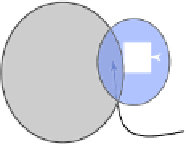Biomedical Engineering Reference
In-Depth Information
H
F
Subset iii- Failure, F
Subset :
ii
Joint Probability:
Intersection of Hazard
and the Failure, F & H
.
Subset
i
- Hazard, H
Set 1 -
Population
Figure 4.3
Joint probability. (
See insert for color representation of the figure
.)
Joint probability refers to the occurrence of two (or more) events happening
and we use the
multiplication rule
shown to define it.
P (
)
=
P (
|
) P (
)
Failure & Hazard
Failure
Hazard
Hazard
It is just a restatement of the equation for conditional probability. Where
the
joint probability, P (Failure and Hazard)
, of the failure is equal to the pro-
portion of the number of times the failure has occurred within the hazard,
P
(Failure
|
Hazard), multiplied by the proportion of the number of times the hazard,
P
(Hazard), has occurred within the population.
Conceptually, it is simply the number of joint occurrences of the hazard and
the harm in reference to the entire population as shown in Figure 4.3.
4.8 STATISTICAL RISK
In statistical literature, risk is often discussed as a simple probability. Statisti-
cians differentiate between two types. A Type I (one) error or alpha level is the
probability of rejecting a hypothesis when it is true. This is the producer's risk.
A Type II (two) error or beta level is the probability of accepting a hypothesis
when it is false. This is the consumer's risk.
These probabilities can be used to calculate risk for defined models. For a
further introduction to probability, see a statistical textbook such as
Introduction
to the Practice of Statistics
, Moore and McCabe [5]. For a good (and humorous)
overview of basic probability, see
The Cartoon Guide to Statistics
, Gonick and
Smith [6].
4.9 RARE EVENTS
“If anything can go wrong, it will.”
—Murphy's Law

















Search WWH ::

Custom Search